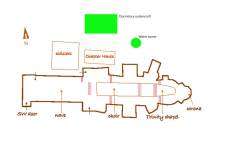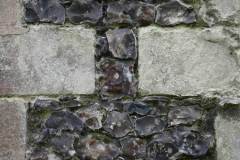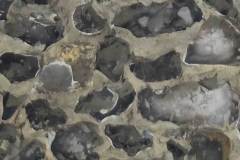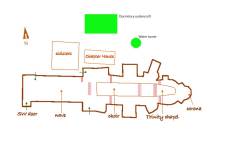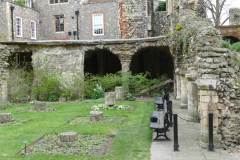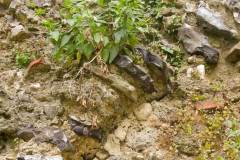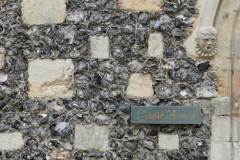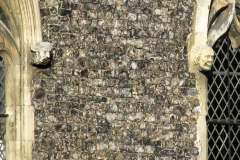Basics
Rock unit: Chalk Group
Age: Upper Cretaceous
Provenance: Local
Where to see examples
The upper limbs of the Water Tower buttresses use fresh flints knapped into squares for decorative effect. Elsewhere in the Water Tower rounded flints from the river gravels have been coarsely mortared into the structure. The core of the cathedral walls and the foundations (both not usually visible) have also used large quantities of flints as rubble infill. Flint in the walls can be seen in the ruins of the infirmary buildings to the north east of the cathedral.
Water Tower (images 1-4 further below)
In the voussoirs (arches) of the Dormitory undercroft (images 5-7 below)
Choir House (images 8 and 9)
Description
Flint is variety of Chert, a family of rocks composed of silica. The term flint is used for various types of silica (e.g. nodules) found in Chalk. Flint found in the fabric of the cathedral building is in the form of nodules and these shapes are broadly related to the various types of burrows of sea creatures that sought refuge or food within the soft calcareous Chalk sea floor. The formation of flint is a series of complex chemical reactions taking place about half a metre below the sea bed where changes in chemistry arose following the decay of organic material. The precipitation of silica from solution was a process of replacement and overgrowth of the burrows within the Chalk.
Flint is a very hard and durable material and in South-east England is the main component of our beaches, river gravels and also occurs as scattered deposits in the landscape as field flints. Fresh flint from the Chalk has a white cortex where there has been partial replacement of the Chalk. Flint for building purposes can be locally obtained from any of these sources.
Flint breaks with a conchoidal fracture, is irregular in shape and difficult to ‘cut’. Beach pebbles and river gravels are often rounded; the latter possessing a dull orange coating, evidence of iron staining and many years exposure to the atmosphere. Flint is usually used to construct rubble walls. Much of the flint found in the fabric of the cathedral has been quarried from the river gravels of the River Stour.
In the water tower much of the flint in the wall has been coarsely knapped and the mason has laid some flints in courses while others appear as random rubble.
Click to enlarge the images and read the captions.
The rear wall of choir house (image 9) contains arguably the highest quality flint work in the city.

